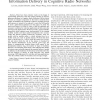Free Online Productivity Tools
i2Speak
i2Symbol
i2OCR
iTex2Img
iWeb2Print
iWeb2Shot
i2Type
iPdf2Split
iPdf2Merge
i2Bopomofo
i2Arabic
i2Style
i2Image
i2PDF
iLatex2Rtf
Sci2ools
235
Voted
TMC
2016
2016
The Impact of Network Size and Mobility on Information Delivery in Cognitive Radio Networks
—There have been extensive works on the design of opportunistic spectrum access and routing schemes to improve spectrum efficiency in Cognitive Radio Networks (CRNs), which becomes an integral component in the future communication regime. Nonetheless, the potentials of CRNs in boosting network performance yet remain to be explored to reach the full benefits of such a phenomenal technique. In this paper, we study the end-to-end latency in CRNs in order to find the sufficient and necessary conditions for real-time applications in finite networks and large-scale deployments. We first provide a general mobility framework which captures most characteristics of the existing mobility models and takes spatial heterogeneity into account. Under this general mobility framework, secondary users are mobile with an mobility radius α, which indicates how far a mobile node can reach in spatial domain. We find that there exists a cutoff point on α, below which the latency has a heavy tail an...
Related Content
| Added | 11 Apr 2016 |
| Updated | 11 Apr 2016 |
| Type | Journal |
| Year | 2016 |
| Where | TMC |
Comments (0)

